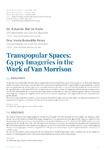Transpopular Spaces: Gypsy Imageries in the Work of Van Morrison

Use este enlace para citar
http://hdl.handle.net/2183/25962Coleccións
- Investigación (FFIL) [885]
Metadatos
Mostrar o rexistro completo do ítemTítulo
Transpopular Spaces: Gypsy Imageries in the Work of Van MorrisonData
2020Cita bibliográfica
Barros Grela, E., & Bobadilla Pérez, M. (2020). Transpopular Spaces: Gypsy Imageries in the Work of Van Morrison. Oceánide, 13, 44-51.
Resumo
[Abstract]The work of Northern Irish singer-songwriter Van Morrison has gone relatively unnoticed by critics despite the numerous social,
literary and artistic elements included in his songs. Among them is the representation of the figure of the Gypsy as a model of action
for generations of listeners who were concerned about countercultural dynamics, as well as alternative life models to those that were
legitimized by the middle class of the time. The objective of this study is to analyze the romanticized component that is presented in
Morrison's work around his conceptualization of gypsyism, as well as to observe how these elements generate, firstly, a deontologizing
function in the Gypsy figure, and then a resignification of the spaces in transit occupied by the imagination(s) of this community as a
nomadic people.
To carry out this analysis, several songs from the first albums of the Northern Irish author will be examined, and we will explain the
function of representing the Gypsy in the countercultural spatial environment of their epistemology. [Resumen] La obra del autor norirlandés Van Morrison ha pasado relativamente desapercibida por la crítica a pesar de los numerosos elementos
sociales, literarios y artísticos que presenta. Entre ellos se encuentra la representación de la figura del gitano como modelo de actuación
para unas generaciones de oyentes a quienes les preocupaba el aspecto cultural a la contra, así como los modelos de vida alternativos a
los legitimados por la clase media de la época. El objetivo de este estudio es analizar el componente romantizado que se presenta en la
obra de Morrison alrededor de su representación del gitanismo, así como observar cómo esos elementos generan primero una función
deontologizante y después una resignificación de los espacios en tránsito ocupados por la(s) imaginación(es) de esta comunidad como
pueblo nómada.
Para llevar a cabo el análisis se atenderá a varias canciones de la primera época del autor norirlandés, y se explicarán las funciones de
representación del gitano en el entorno del espacio y de una epistemología contracultural
Palabras chave
Van Morrison
Space
Gypsies
Counterculture
Music
Espacio
Gitanos
Contracultura
Música
Space
Gypsies
Counterculture
Music
Espacio
Gitanos
Contracultura
Música
Versión do editor
Dereitos
Aribución 4.0
ISSN
ISSN 1989-6328






